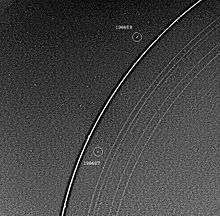
Back Cordelia (maan) Afrikaans Cordelia (satelite) AN كورديليا (قمر) Arabic کوردئلیا (اویدو) AZB Кардэлія (спадарожнік Урана) Byelorussian Кардэлія (спадарожнік) BE-X-OLD Корделия (спътник) Bulgarian কর্ডেলিয়া (প্রাকৃতিক উপগ্রহ) Bengali/Bangla Kordelija (mjesec) BS Cordèlia (satèl·lit) Catalan
 Cordelia (lower-middle, inside of bright ring), as imaged by Voyager 2 | |
| Discovery | |
|---|---|
| Discovered by | Richard J. Terrile / Voyager 2 |
| Discovery date | January 20, 1986 |
| Orbital characteristics | |
Mean orbit radius | 49751.722 ± 0.149 km |
| Eccentricity | 0.00026 ± 0.000096 |
| 0.33503384 ± 0.00000058 d | |
| Inclination | 0.08479 ± 0.031° (to Uranus' equator) |
| Satellite of | Uranus |
| Physical characteristics | |
| Dimensions | 50 × 36 × 36 km |
Mean radius | 21 ± 3 km |
| ~5500 km² | |
| Volume | ~38,900 km³ |
| Mass | ~5.0×1016 kg |
Mean density | ~1.3 g/cm³ assumed |
| ~0.0073 m/s² | |
| ~0.017 km/s | |
| synchronous | |
| zero | |
| Albedo | 0.08 ± 0.01 |
| Temperature | ~64 K |
Cordelia is the closest moon to Uranus. It was found from the images taken by Voyager 2 on January 20, 1986, and was given the designation S/1986 U 7. It was not seen again until the Hubble Space Telescope observed it in 1997. Cordelia takes its name from the youngest daughter of Lear in William Shakespeare's King Lear. It is also designated Uranus VI. This moon is 148 kilometres (92 mi) wide and is the same size of Mars' smallest moon called Deimos.